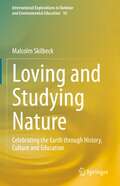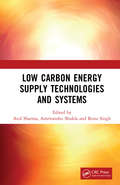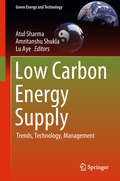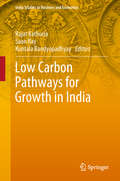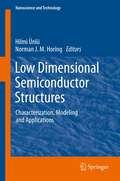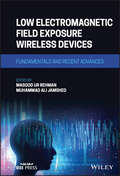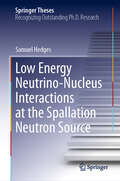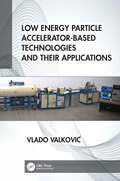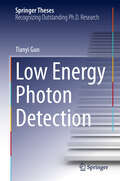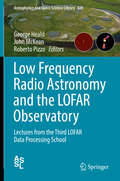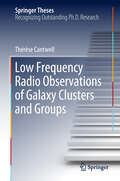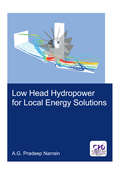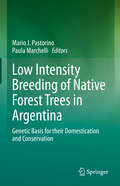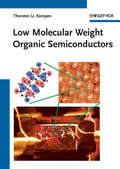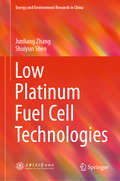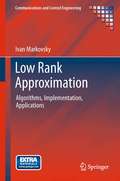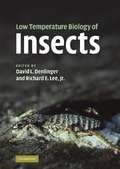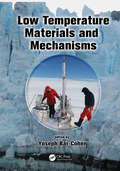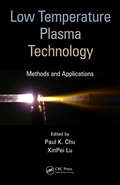- Table View
- List View
Love on a Leash
by Liz PalikaFrom the Book jacket: Can my dog do therapy work? * Who can train a therapy dog? What does the owner need to know? How can my dog become certified? What problems am I likely to encounter? *Should our facility have its own resident therapy pet? If you have been asking some of these questions, Love On A Leash is the book for you! Liz Palika is an expert on dogs, training, and therapy work. 'Through her efforts thousands of people have been touched with canine affection. Now she shares that experience. Love on a Leash gives you all the tips, methods, and techniques for choosing, training, and working with a therapy dog, as well as telling you how to make your visit a success. You just may discover that you have a four-footed therapist waiting to share miraculous canine love!
Love, Ish
by Karen RiversMischa "Ish" Love knows she'll be one of the first settlers on Mars. She's applied to - and been rejected from - the Mars Now project forty-seven times, but the mission won't leave for ten years, and Ish hasn't given up hope. She also hasn't given up hope that Tig will be her best friend again. When Ish collapses on the first day of seventh grade, she gets a diagnosis that threatens all her future plans. As Ish fights cancer, she dreams in vivid detail about the Martian adventures she's always known she'd have - and makes unexpected discoveries about love, fate, and her place in the vast universe.
Love, Ish (Penworthy Picks Middle School Ser.)
by Karen RiversMy name is Mischa “Ish” Love, and I am twelve years old. I know quite a lot about Mars. Mars is where I belong. Do you know how sometimes you just know a thing? My mom says that falling in love is like that, that the first time she saw Dad, she just knew. That’s how I feel about Mars: I just know. I’m smart and interesting and focused, and I’m working on getting along better with people. I’ll learn some jokes. A sense of humor is going to be important. It always is. That’s what my dad always says. Maybe jokes will be the things that will help us all to survive. Not just me, because there’s no “me” in “team,” right? This is about all of us. Together. What makes me a survivor? Mars is going to make me a survivor. You’ll see. * In Karen Rivers’s riveting new novel, Ish’s dreams for a future on Mars go heartbreakingly awry when an unexpected diagnosis threatens to rewrite her whole future.
Loving and Studying Nature: Celebrating the Earth through History, Culture and Education (International Explorations in Outdoor and Environmental Education #10)
by Malcolm SkilbeckThis volume investigates crucial ways in which nature has been apprehended, understood and valued in different cultures and over time. It is grounded in current global concerns about growing threats to the natural environment. Through a critical appraisal of specific examples, it ranges widely over historical and contemporary attitudes and behaviours.It presents a wide ranging analysis of selected ideas and attitudes in the evolution mainly of western civilisation, from the time of the cave artists to the present day. It argues for preservation and conservation of the natural resources and beauty of the earth in the face of religious supernatural arguments and the rise of consumer capitalism and consumerism.
Low Calorie and Special Dietary Foods
by B.K. DwivediThis book is based on the papers presented at the Symposium on Low Calorie and Special Dietary Foods at the annual meeting of the Institute of Food Technologies in Anaheim California on June 8, 1976.
Low Carbon Energy Supply Technologies and Systems
by Atul Sharma Renu Singh Amritanshu ShuklaFuture energy technologies must embrace and achieve sustainability by displacing fossil carbon-intensive energy consumption or capture/reuse/sequester fossil carbon. This book provides a deeper knowledge on individual low (and zero) carbon technologies in a comprehensive way, covering details of recent developments on these technologies in different countries. It also covers materials and processes involved in energy generation, transmission, distribution, storage, policies, and so forth, including solar electrical; thermal systems; energy from biomass and biofuels; energy transmission, distribution, and storage; and buildings using energy-efficient lighting.
Low Carbon Energy Supply: Trends, Technology, Management (Green Energy and Technology)
by Atul Sharma Amritanshu Shukla Lu AyeThis book focuses on recent trends in the areas of green and renewable energy, especially as applied to the carbon footprint of energy production, transmission, and use. Discussing the latest developments and advances in the materials and processes involved in energy generation, transmission, distribution and storage, with a particular focus on the management and policies related to these systems, it is a valuable resource for researchers, practitioners, and policy makers working in these areas.
Low Carbon Materials and Technologies for a Sustainable and Resilient Infrastructure: Select Proceedings of CBKR 2023 (Lecture Notes in Civil Engineering #440)
by Rathish Kumar Pancharathi Christopher K. Y. Leung J. M. Chandra KishenThis book presents select proceedings of the International Conference on Cement and Building Koncrete infrastructure for sustainability and Resilience (CBKR-2023). It discusses the latest technologies and innovative and non-conventional materials for sustainable built environment. The topics covered include alternate, sustainable, cost-effective, and smart materials and technologies. It also covers applications of artificial intelligence and machine learning in construction, MCDM techniques, performance-based design, and 3D printing technologies. The book is useful for researchers and professionals in the area of civil engineering and materials science.
Low Carbon Pathways for Growth in India (India Studies in Business and Economics)
by Rajat Kathuria Saon Ray Kuntala BandyopadhyayThis book explores ways in which India can negotiate the low carbon path up until 2030, when it is expected to be the largest economy after the US and China. It comprehensively reviews the low climate pathways for India and provides a guide to the pathways that the country can adopt. India’s population, energy demands and emissions will increase significantly, and the challenge is to restrict its CO2 emissions and walk the low carbon path. Through its Intended Nationally Determined Contributions (INDCs), India has pledged to reduce its emissions significantly.Addressing the question of which low carbon paths India can adhere to without compromising its growth, the book identifies the key factors that feed into existing models of climate change and discusses the cost of action versus inaction. It also examines key issues concerning India’s environment through the lens of the transport, industry and water sectors. The book concludes by looking at policy implications for low carbon growth in India.
Low Dimensional Semiconductor Structures
by Norman J. Horing Hilmi ÜnlüStarting with the first transistor in 1949, the world has experienced a technological revolution which has permeated most aspects of modern life, particularly over the last generation. Yet another such revolution looms up before us with the newly developed capability to control matter on the nanometer scale. A truly extraordinary research effort, by scientists, engineers, technologists of all disciplines, in nations large and small throughout the world, is directed and vigorously pressed to develop a full understanding of the properties of matter at the nanoscale and its possible applications, to bring to fruition the promise of nanostructures to introduce a new generation of electronic and optical devices. The physics of low dimensional semiconductor structures, including heterostructures, superlattices, quantum wells, wires and dots is reviewed and their modeling is discussed in detail. The truly exceptional material, Graphene, is reviewed; its functionalization and Van der Waals interactions are included here. Recent research on optical studies of quantum dots and on the physical properties of one-dimensional quantum wires is also reported. Chapters on fabrication of nanowire - based nanogap devices by the dielectrophoretic assembly approach. The broad spectrum of research reported here incorporates chapters on nanoengineering and nanophysics. In its presentation of tutorial chapters as well as advanced research on nanostructures, this book is ideally suited to meet the needs of newcomers to the field as well as experienced researchers interested in viewing colleagues' recent advances.
Low Earth Orbit Satellite Design
by George Sebestyen Steve Fujikawa Nicholas Galassi Alex ChuchraIn recent decades, the number of satellites being built and launched into Earth’s orbit has grown immensely, alongside the field of space engineering itself. This book offers an in-depth guide to engineers and professionals seeking to understand the technologies behind Low Earth Orbit satellites.With access to special spreadsheets that provide the key equations and relationships needed for mastering spacecraft design, this book gives the growing crop of space engineers and professionals the tools and resources they need to prepare their own LEO satellite designs, which is especially useful for designers of small satellites such as those launched by universities. Each chapter breaks down the various mathematics and principles underlying current spacecraft software and hardware designs.
Low Electromagnetic Field Exposure Wireless Devices: Fundamentals and Recent Advances
by Masood Ur Rehman Muhammad Ali JamshedLOW ELECTROMAGNETIC FIELD EXPOSURE WIRELESS DEVICES Comprehensive resource covering methods of designing energy efficient and low EMF wireless device techniques Supported with real case studies and recent advancements and laying the foundation for future advancements in the field, Low Electromagnetic Field Exposure Wireless Devices: Fundamentals and Recent Advances describes both ways, i.e. hardware and software, in which the user-centric wireless communication devices can be designed to reduce the levels of EMF to limit the potential long-term effects of EMF on human health. The text covers state-of-the-art and advanced topics such as EMF exposure standards and rationale, EMF evaluation tools, radio resource allocation, energy conservation, energy harvesting, EMF-aware antenna designs, and MIMO, and highlights advancements in this exciting field to date. To aid reader comprehension, the text contains numerous tables, illustrations, and photographs. In Low Electromagnetic Field Exposure Wireless Devices: Fundamentals and Recent Advances, readers can expect to find information on: Fundamentals and key practices, and mechanisms and assessment methods, of exposure to electromagnetic fields The role of the smartphone on the assessment of exposure from 5G and antenna design considerations and techniques for low SAR mobile handsets Numerical exposure assessments of communication systems at higher frequencies and age-dependent exposure estimation using numerical methods Reinforcement learning and device-to-device communication in minimizing EMF exposure and emission-aware uplink resource allocation scheme for non-orthogonal multiple access systems For wireless user equipment designers and hardware engineers, teachers in wireless communications, and postgraduate students in antennas for communication systems, Low Electromagnetic Field Exposure Wireless Devices: Fundamentals and Recent Advances is a must-have resource, covering an important topic that is expected to only grow in significance as future technological developments are made.
Low Energy Neutrino-Nucleus Interactions at the Spallation Neutron Source (Springer Theses)
by Samuel HedgesThis thesis highlights the development and analysis of multiple neutrino detectors deployed to the Spallation Neutron Source (SNS) at Oak Ridge National Laboratory as part of the COHERENT experiment. It includes a preliminary measurement of the neutrino-induced neutron cross section on lead, and analysis that led to the first inclusive electron-neutrino charged-current measurement on iodine. These results add to the small number of inelastic neutrino-nucleus cross sections measured in this energy range, which are useful for understanding supernova and solar neutrino detection sensitivity. Additionally, it discusses preliminary work for and design of COHERENT’s ton-scale NaI coherent elastic neutrino-nucleus scattering (CEvNS) detector, currently being deployed to the SNS. Finally, it includes information on a campaign to measure the nuclear recoil quenching factor of NaI using multiple crystals, attempting to resolve inconsistencies with existing measurements.
Low Energy Particle Accelerator-Based Technologies and Their Applications
by Vlado ValkovićLow Energy Particle Accelerator-Based Technologies and Their Applications describes types of low energy accelerators, presents some of the main manufacturers, illustrates some of the accelerator laboratories around the globe and shows examples of successful transfers of accelerators to needed laboratories. Key Features: Presents new trends and the state of the art in a field that's growing Provides an overview of numerous applications of such accelerators in medicine, industry, earth sciences, nuclear non-proliferation and oil Fills a gap, with the author drawing on his own experiences with transporting such relatively large machines from one lab to the other that require a tremendous amount of planning, technical and engineering efforts This is an essential reference for advanced students as well as for physicists, engineers and practitioners in accelerator science. About the Author Dr. Vladivoj (Vlado) Valković, a retired professor of physics, is a fellow of the American Physical Society and Institute of Physics (London). He has authored 22 books (from Trace Elements, Taylor & Francis, 1975, to Radioactivity in the Environment, Elsevier, 1st Edition 2001, 2nd Edition 2019), and more than 400 scientific and technical papers in the research areas of nuclear physics, applications of nuclear techniques to trace element analysis in biology, medicine and environmental research. He has lifelong experience in the study of nuclear reactions induced by 14 MeV neutrons. This research has been done through coordination and works on many national and international projects, including US-Croatia bilateral, NATO, IAEA, EU-FP5, FP6 and FP7 projects. Cover photo credit: 3SDH 1 MV Pelletron system with RF source and analysis endstation designed with the intended purpose of aiding in fusion research. It is capable of Ion Beam Analysis (IBA) techniques such as RBS, ERD, PIXE and NRA. Further detectors could be added to the endstation to allow for other techniques. Installed in Japan in 2014. Courtesy of National Electrostatics Corp.
Low Energy Photon Detection (Springer Theses)
by Tianyi GuoThis thesis showcases innovative new approaches aimed at advancing the next generation of long wave infrared (LWIR) light detectors and cameras. Detecting LWIR light at room temperature has posed a persistent challenge due to the low energy of photons. The pursuit of an affordable, high-performance LWIR camera capable of room temperature detection has spanned several decades. The two approaches detailed within are designed to offer high detectivity, swift response times, and room temperature operation. The first involves harnessing the Dirac plasmon and the Seebeck effect in graphene to create a photo-thermoelectric detector. The second entails the use of an oscillating circuit integrated with phase change materials and the modulation of frequency induced by infrared illumination to achieve LWIR detection. Finally, the graphene-based detectors are integrated with readout circuits to enable the development of a dense pixel focal plane which has strong potential for commercialization. The journey from novel material to device to functional camera presented here is essential reading for researchers in the field of photon detection.
Low Frequency Radio Astronomy and the LOFAR Observatory: Lectures from the Third LOFAR Data Processing School (Astrophysics and Space Science Library #426)
by George Heald John McKean Roberto PizzoThis book presents lecture materials from the Third LOFAR Data School, transformed into a coherent and complete reference book describing the LOFAR design, along with descriptions of primary science cases, data processing techniques, and recipes for data handling. Together with hands-on exercises the chapters, based on the lecture notes, teach fundamentals and practical knowledge. LOFAR is a new and innovative radio telescope operating at low radio frequencies (10-250 MHz) and is the first of a new generation of radio interferometers that are leading the way to the ambitious Square Kilometre Array (SKA) to be built in the next decade. This unique reference guide serves as a primary information source for research groups around the world that seek to make the most of LOFAR data, as well as those who will push these topics forward to the next level with the design, construction, and realization of the SKA. This book will also be useful as supplementary reading material for any astrophysics overview or astrophysical techniques course, particularly those geared towards radio astronomy (and radio astronomy techniques).
Low Frequency Radio Observations of Galaxy Clusters and Groups (Springer Theses)
by Thérèse CantwellThis book uses new data from the very low radio frequency telescope LOFAR to analyse the magnetic structure in the giant radio galaxy NGC6251. This analysis reveals that the magnetic field strength in the locality of this giant radio galaxy is an order of magnitude lower than in other comparable systems. Due to the observational limitations associated with capturing such huge astrophysical structures, giant radio galaxies are historically a poorly sampled population of objects; however, their preferential placement in the more rarefied regions of the cosmic web makes them a uniquely important probe of large-scale structures. In particular, the polarisation of the radio emissions from giant radio galaxies is one of the few tools available to us that can be used to measure magnetic fields in regions where the strength of those fields is a key differentiator for competing models of the origin of cosmic magnetism. Low frequency polarisation data are crucial for detailed analyses of magnetic structure, but they are also the most challenging type of observational data to work with. This book presents a beautifully coupled description of the technical and scientific analysis required to extract valuable information from such data and, as the new generation of low frequency radio telescopes reveals the larger population of giant radio galaxies, it offers a significant resource for future analyses.
Low Head Hydropower for Local Energy Solutions (IHE Delft PhD Thesis Series)
by Pradeep NarrainThe role of small hydropower is becoming increasingly important on a global level. Increasing energy demand and environmental awareness has further triggered research and development into sustainable low-cost technologies. In developing countries, particularly in rural areas, the possibility of local power generation could considerably improve living conditions. With this in mind, the development of a next generation low-head hydropower machines was subject of investigation in the EU-project HYLOW. Being part of the research lines of that project, this thesis presents a numerical modelling approach to improve the design of machines like water wheels for increased hydraulic efficiency. Nowadays, Computational Fluid Dynamics (CFD) enables numerical models to be quite accurate and incorporate physical complexities like free surfaces and rotating machines. The results of the CFD simulations carried out in this research show that a change in blade geometry can result in higher torque levels, thereby increasing performance. Numerical simulations also enabled to determine the optimal wheel-width to channel-width ratio and further improve performance by modifying the channel bed conditions upstream and downstream of the water wheel. With a power rating in the low kilowatt range, low-head hydropower machines like optimised water wheels seem to have a clear potential for small-scale energy generation, thereby contributing to achieving the Sustainable Development Goals by providing local energy solutions.
Low Intensity Breeding of Native Forest Trees in Argentina: Genetic Basis for their Domestication and Conservation
by Mario J. Pastorino Paula MarchelliGlobal climate change requires the development of programs that consider the active restoration of degraded forests and the use of native trees in afforestation to preserve the natural environment. International commitments like the UN REDD program, the Montréal Process and the Convention on Biological Diversity call for the breeding of species rarely contemplated by large industrial companies. Low-intensity breeding is the most rational strategy for those species: simple but robust, and not dependent on continuously increasing funding, and therefore effective even with a relatively small budget. It commonly focuses on high genetic diversity rather than improving economic traits and adaptability rather than productivity. Controlled crosses with full pedigrees typical of high-intensity breeding are replaced by open pollination. This book presents state-of-the-art breeding strategies from the last two decades for several forest tree species of prime importance in the natural forests of Argentina. They are distributed in the three main forestry ecoregions of the country: the subtropical dry forest (Chaco), the subtropical rain forests (Yungas and Alto Paraná rainforests) and the temperate forests of Patagonia. The book also discusses the genetic patterns of the selected species defined using genetic markers together with the analysis of the variation in quantitative traits. Further, it examines the crucial features of their reproductive biology, such as the mating system and gene flow and describes the current breeding programs. Lastly, it presents the latest developments in genetic resources and their emerging applications, concluding with some reflections and perspectives related to the conditioning imposed by climate change.
Low Molecular Weight Organic Semiconductors
by Thorsten U. KampenThis up-to-date reference for students and researchers in the field is the first systematic treatment on the property measurements of organic semiconductor materials. Following an introduction, the book goes on to treat the structural analysis of thin films and spectroscopy of electronic states. Subsequent sections deal with optical spectroscopy and charge transport. An invaluable source for understanding, handling and applying this key type of material for physicists, materials scientists, graduate students, and analytical laboratories.
Low Platinum Fuel Cell Technologies (Energy and Environment Research in China)
by Junliang Zhang Shuiyun ShenThis book introduces readers to the fundamental physics and chemistry of the proton exchange membrane fuel cell (PEMFC), followed by discussions on recent advances in low platinum electrocatalysis and related catalyst development for PEMFC (the book’s primary focus), methods of membrane electrode assembly (MEA) fabrication for low platinum catalysts, and durability issues in connection with MEA. While energy and environmental issues are becoming the two main subjects in global sustainable development, the proton exchange membrane fuel cell (PEMFC), a clean and efficient new energy technology, has attracted more and more attention in recent years The major hurdle for more extensive applications of the PEMFC, especially for the automotive sector, is the high platinum loading requirement. Readers will gain a comprehensive understanding of the fundamentals and methods of low platinum PEMFC. This book is intended for researchers, engineers and graduate students in the fields of new energy technology, the fuel cell vehicle industry and fuel cell design.
Low Rank Approximation
by Ivan MarkovskyData Approximation by Low-complexity Models details the theory, algorithms, and applications of structured low-rank approximation. Efficient local optimization methods and effective suboptimal convex relaxations for Toeplitz, Hankel, and Sylvester structured problems are presented. Much of the text is devoted to describing the applications of the theory including: system and control theory; signal processing; computer algebra for approximate factorization and common divisor computation; computer vision for image deblurring and segmentation; machine learning for information retrieval and clustering; bioinformatics for microarray data analysis; chemometrics for multivariate calibration; and psychometrics for factor analysis. Software implementation of the methods is given, making the theory directly applicable in practice. All numerical examples are included in demonstration files giving hands-on experience and exercises and MATLAB® examples assist in the assimilation of the theory.
Low Temperature Biology of Insects
by David L. Denlinger Richard E. Lee Jr.Low temperature is a major environmental constraint impacting the geographic distribution and seasonal activity patterns of insects. Written for academic researchers in environmental physiology and entomology, this book explores the physiological and molecular mechanisms that enable insects to cope with a cold environment and places these findings into an evolutionary and ecological context. An introductory chapter provides a primer on insect cold tolerance and subsequent chapters in the first section discuss the organismal, cellular and molecular responses that allow insects to survive in the cold despite their, at best, limited ability to regulate their own body temperature. The second section, highlighting the evolutionary and macrophysiological responses to low temperature, is especially relevant for understanding the impact of global climate change on insect systems. A final section translates the knowledge gained from the rest of the book into practical applications including cryopreservation and the augmentation of pest management strategies.
Low Temperature Materials and Mechanisms
by Yoseph Bar CohenThis book addresses the growing interest in low temperature technologies. Since the subject of low temperature materials and mechanisms is multidisciplinary, the chapters reflect the broadest possible perspective of the field. Leading experts in the specific subject area address the various related science and engineering chemistry, material science, electrical engineering, mechanical engineering, metallurgy, and physics.
Low Temperature Plasma Technology: Methods and Applications
by Paul K. Chu XinPei LuWritten by a team of pioneering scientists from around the world, Low Temperature Plasma Technology: Methods and Applications brings together recent technological advances and research in the rapidly growing field of low temperature plasmas. The book provides a comprehensive overview of related phenomena such as plasma bullets, plasma penetration i



